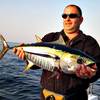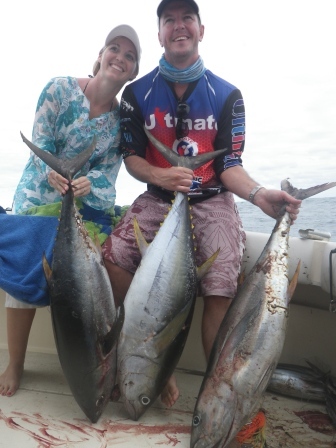Yellowfin Tuna is one of my favourite species to target when heading offshore, they are abundant, you can catch them using so many methods, they fight hard and they taste good.
The name Tuna derives from the Greek verb "thuno" meaning "to rush, and that is exactly how a Tuna will fight, a local nick name that we give them here is Gas Bottles, because of their compact muscle filled torpedo shaped bodies, and off course when a gas bottles lid blows goes off it is virtually unstoppable.
Tuna are an amazing species and unique when compared to other game fish species and so I usually consider Tuna a species all on their own. Tuna are warm blooded (endothermic) which means that they can alter their body temperature and so control their metabolism according to their environment. This ability allows Tuna to live in a wide range of temperatures from 16 � 28 deg. C, and gives them the stamina and endurance needed to maintain high speeds for long periods of time. This is also what makes them such a worthy opponent on a rod and reel.
Tuna always need to be moving as their body requires large amounts of oxygen in their muscles and blood of which they have at least twice as vessels compared to other species causing their flesh to be redder and darker than other fish.
Yellowfin Tuna have a magnetic sensing organ in their heads, change colour when excited and when cruising swim at around 14-15km/hr with top speeds just below 90km/hr.
You can find Yellowfin Tuna on the warm side of currents and warm spots, on the edge of colour lines, where there is a lot of bait, swimming with Dolphins, on the peripheries of reefs, pinnacles and ledges and more often than not where you find feeding bird activity.
I find that Yellowfin Tuna often come into the shallows early morning and late afternoon and spend most of the day out in the deeper waters, but there are many other factors to consider, especially food source. Yellowfin Tuna can be found along our coast line almost all year, with most activity from Spring through to Autumn; late Spring to Early Autumn is peak season on our coast.
Just a short note on birds, usually along our coast Tuna are associated with the little birds we locally call "Sterkies" (Little Stars), if you see these birds all moving in a direction usually it means they are heading towards a feeding area. When you find them circling, diving and hovering it means that they have found a feeding area which almost always means that Yellowfin Tuna are in the vicinity. The height that these birds hover from the water usually indicates the depth that the school of Tuna is feeding or chasing the bait shoal.
There are so many methods that can be effective to catch Yellowfin Tuna, and I will mention the methods and techniques that I have used successfully, but there are other methods also.
Live Baiting
Generally Yellowfin Tuna prefer smaller live baits, so Mackerel, Mozzies, Pinkies, Piggies all make good live baits. The best method is to free drift these baits on a 100lb fluorocarbon leader with a 7/0 -9/0 circle hook tied with a Snell, or a 6/0-8/0 hook on a small loop. You can push the hooks through the mouth, nose, behind the neck, dorsal fin or by the tail. If the currents are too strong you may need to add weight or even down rig these baits.
Chumming
You can add a chum trail of finely minced sardines whilst the boat is on the drift, and then deploy your live baits, cast poppers, lures and spoons, and use bucktail and vertical jigs.
This works particularly well when you have found a shoal of Yellowfin Tuna feeding on the surface and you then position you boat upwind from the shoal and wait for them to come to you, this method will not spook the shoal and so they will not sound (go deep).
Chunking
This is a very effective way to get Yellowfin Tuna into a feeding frenzy, and as mentioned above will work magic once you have found a feeding shoal.
Trolling
Trolling lures is also very effective and mostly I run 5 lines behind my boat in either a "V" or "W" pattern, the speed will vary each day but I find that 9km/hr seems to work well for me in the waters I fish. The range of lures that Tuna will eat is wide and I will list what I have used successfully.
� Shallow and deep Running Rapala's and Halco's from small to large
� Tuna Feathers
� Bullets
� Jet Feathers
� Jet Head skirted Lures
� Plugs, especially Cedar Plugs
� Small Kona's
In general Yellowfin Tuna prefer smaller lures, but larger ones have also produced the goods on many occasions.
Plugging, Spinning and Jigging
Plugging and Spinning are very effective for casting at a shoal, whilst Vertical Jigging will get you the Tuna down deep. Typically I will after trolling once I have found a shoal, where I will drift my boat upwind from the shoal, you can if you like chum the water with fine chum as this will keep the shoal around you boat for longer. Then 1 or 2 anglers will cast towards the shoal with plugging or spinning tackle with the wind behind them, whilst another 1 or 2 anglers will Jig on the opposite side.
When casting at the shoal, always cast on the outsides as this is where the bigger Yellowfin Tuna will hang out.
Remember to match your tackle for the size fish you expect to encounter as Yellowfin can get Huge and push any tackle to its limits.



